Winter in the Mount Washington Valley | Winter’s Playground
Endless options in New Hampshire’s Mount Washington Valley let you take the season at your own speed.
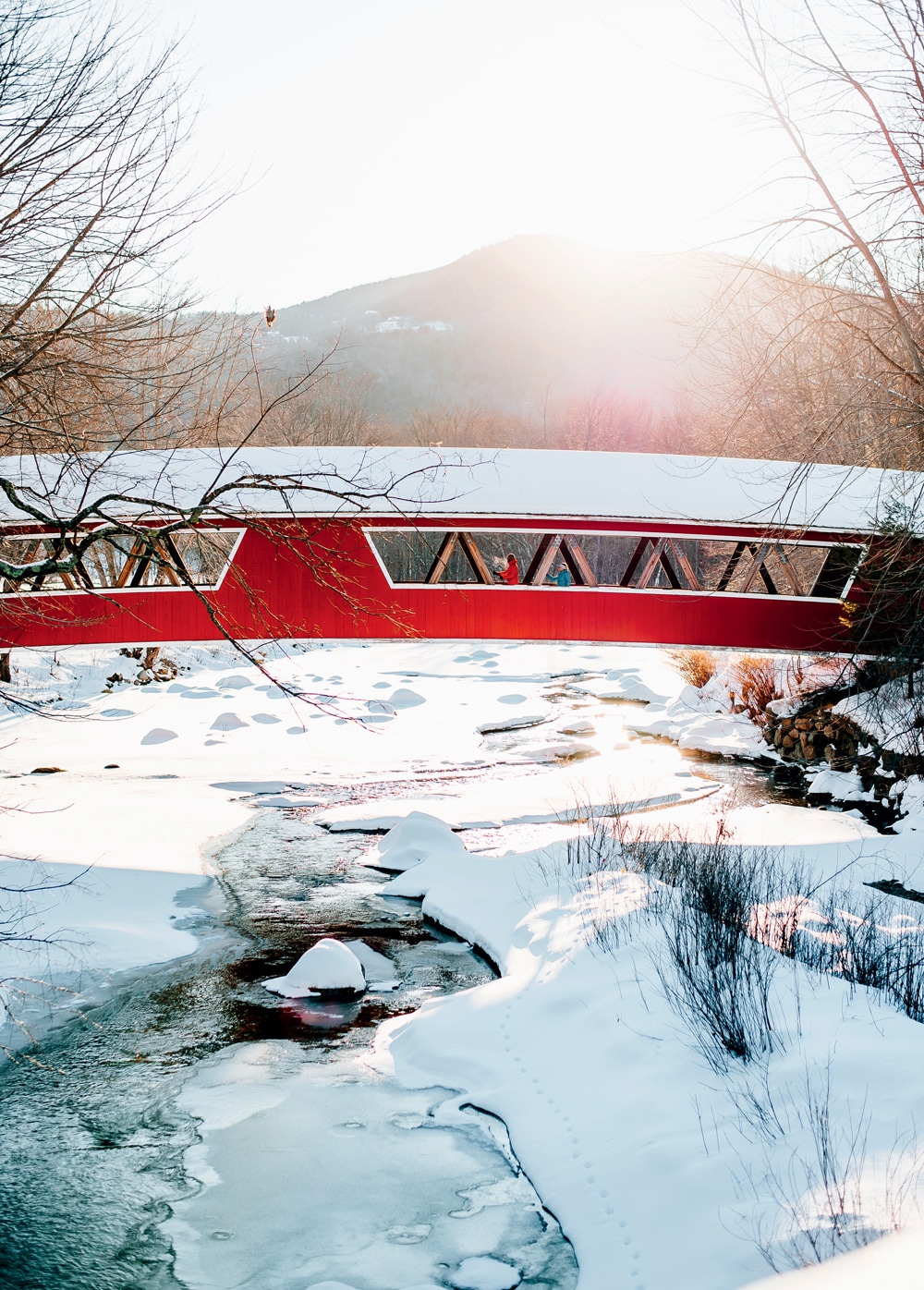
Snapshots from a day at the Jackson Ski Touring Foundation, better known as Jackson XC. The nonprofit was chartered in 1972 to maintain trails in and around the town, and today it serves as a gateway to 150 kilometers of prime cross-country and snowshoeing routes.
Photo Credit : Cait Bourgault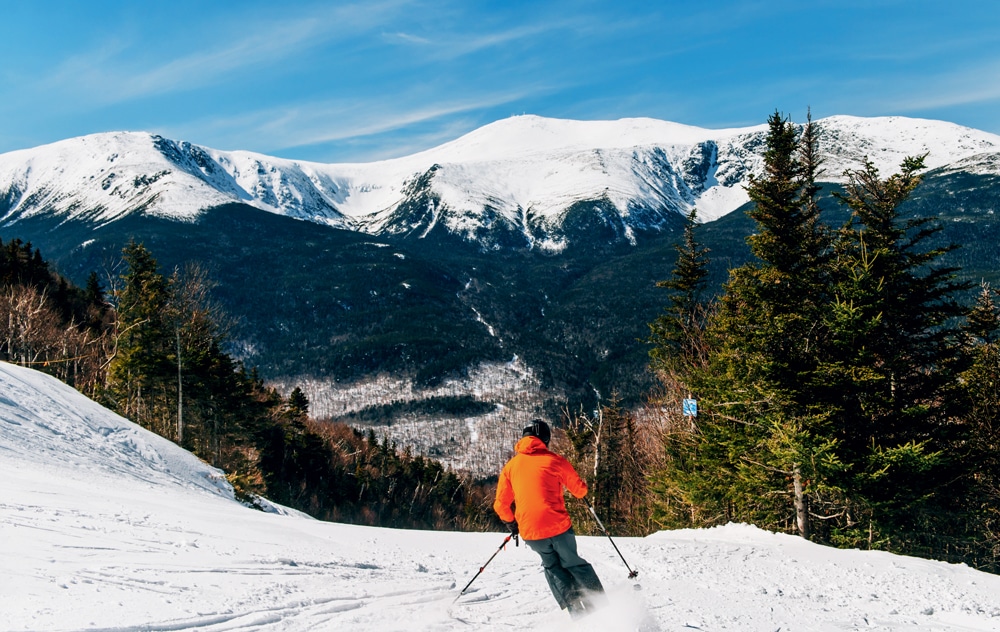
Photo Credit : Cait Bourgault
It had been a good 90 minutes since I’d last seen my son when I finally spotted him. I was halfway into my chairlift ride when a familiar 9-year-old figure came into view, his body jutting forward as he rocketed down a black diamond run just below me.
“Calvin!” I yelled, but I might as well have been calling to the snow. He barreled downward as though he had the trail to himself.
Which he pretty much did. It was a Tuesday at Cranmore Mountain in North Conway, New Hampshire, mere weeks before a pandemic would upend the world, and we’d managed to just about grab first tracks. But what started as a father-son day quickly dissolved after our initial run. Our two-man band was kaput.
Back at the top of the lift, I waited for Calvin to reappear. “How about another run together?” I asked. He fell silent for a moment, searching for the right words.
“I kind of want to go fast, Dad,” he said, finally. Then he smiled and skied off by himself.
It was official: I’d lost my son to the White Mountains.
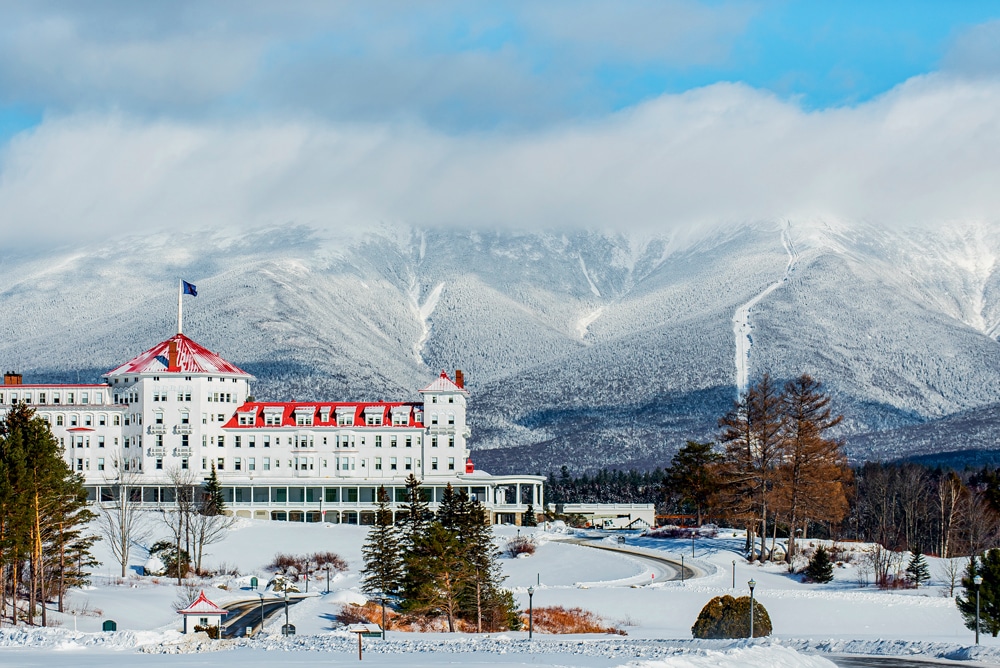
Photo Credit : Cait Bourgault
I shouldn’t have been surprised. Over the past several winters we’ve regularly ventured to the Mount Washington Valley. Though New England is populated with many fine skiing regions, nothing quite matches the diversity of terrain found in the seven Alpine ski areas here. These mountains garner the kind of loyalty usually reserved for sports teams. Smaller, family resorts like Cranmore and Black Mountain in nearby Jackson share the neighborhood with the same steep wilderness runs that helped birth the American Alpine scene. You can glide down a nearly three-mile-long green at Wildcat, blast down one of New Hampshire’s steepest trails at King Pine, find solitude in the glades at Bretton Woods, or take a crack at the hundreds of miles of Nordic trails that course through the region. We’ve adventured in snow in other parts of New England, but it was in this valley that my son truly fell in love with winter.
And why wouldn’t he? Here, a winter day can feel as light and carefree as any Sunday in summer. There is no judgment. You can go as hard or as soft as you want. If you know what you’re doing, you can hike up Mount Washington. You can scale some of the best ice climbing routes in the country. You can cross-country ski to the brink of exhaustion. Heck, you can even zipline. There are so many ways to get up and down in the snow, it’s almost as if you’ve landed in winter’s own playground.
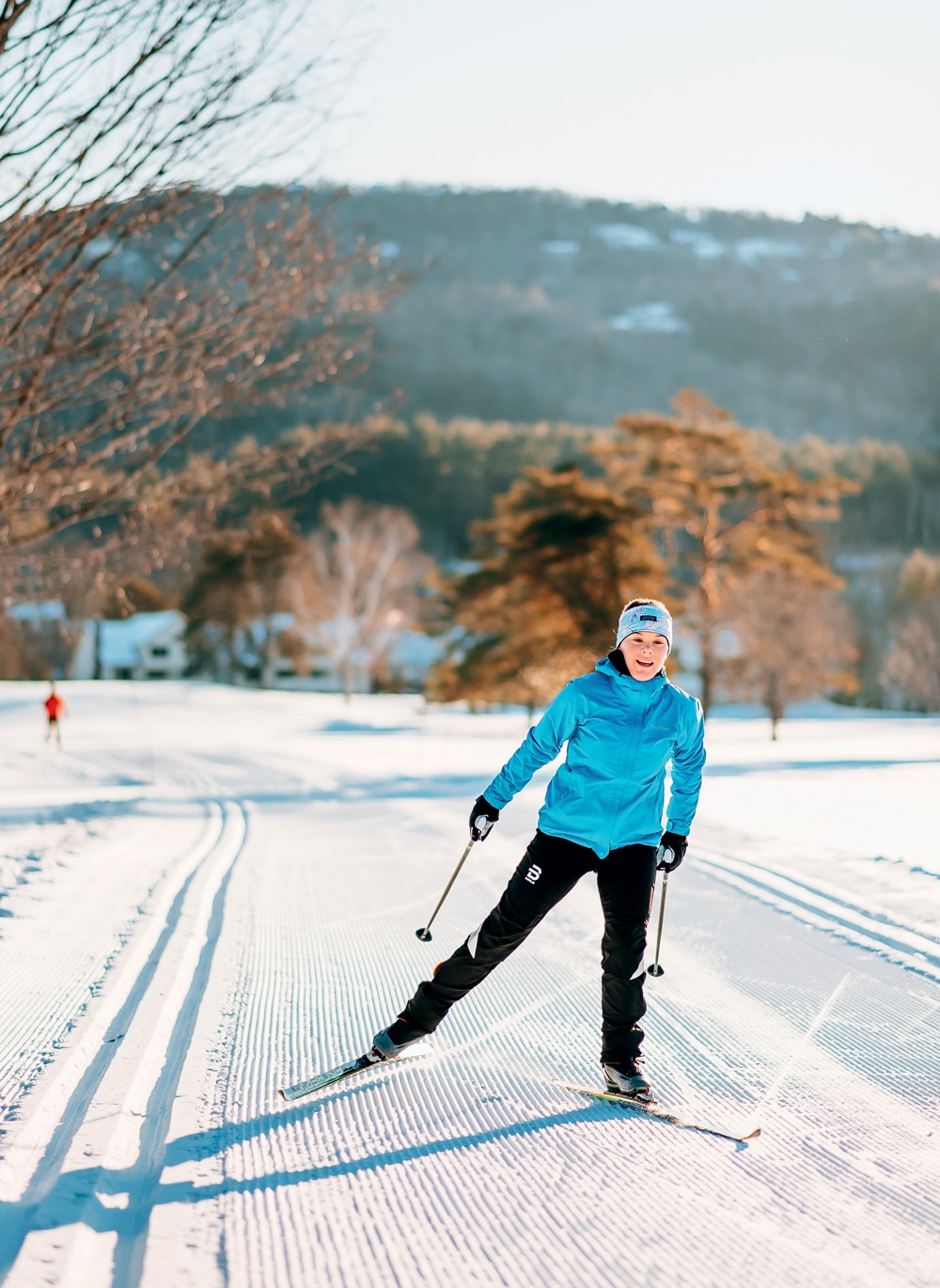
Photo Credit : Cait Bourgault
But you can also live large at the preeminent grand hotel in the Northeast. You can drink local beers, eat local food, and lose yourself in a sprawling shopping trip. You can even ascend part of the Mount Washington Auto Road from the cozy confines of a transport van that rides on tractor treads as it takes you to a landscape few ever see.
You can, in other words, throw yourself into the beauty of the season—or just take it in. Either way, there’s no getting around the fact that you’re more than likely to come away from the Mount Washington Valley liking winter just a little bit more.
—
That night, after father was dusted by son on the slopes, the two of us slid into a booth at the Red Fox Bar & Grille in Jackson. Valley evangelists are everywhere, and as we dove into nachos and burgers, I asked our server if he and his family skied. He gave me a look as if I had asked whether he breathed oxygen.
“A little,” he said with a laugh. “But I get most of it starting in February, after the schools have come through and the days are longer. My daughter works at Cranmore, and last year my grandson squeezed in 122 days on the mountain.” He leaned in a little closer to drive home his point. “He was only 5.”
I encountered more of that good-natured winter bravado at the REI Co-op in North Conway, where winter was getting a big old bear hug. Opened in 2019, the store represents the West Coast retailer’s entry into New Hampshire, and it cut no corners in making a good first impression. I knew the space: It had been the former home of Eastern Mountain Sports. But in its revitalized form it was unrecognizable, packing a kind of coffee-shop-meets-warehouse vibe. Racks of climbing ropes and rows of bikes hung from the walls. There were long stretches of tents and other camping equipment. A leather couch anchored a sitting area, a big wall mapped out employee-recommended hikes, and scratchy indie music played in the background. More than a place to shop, it felt like an homage to the outdoors.
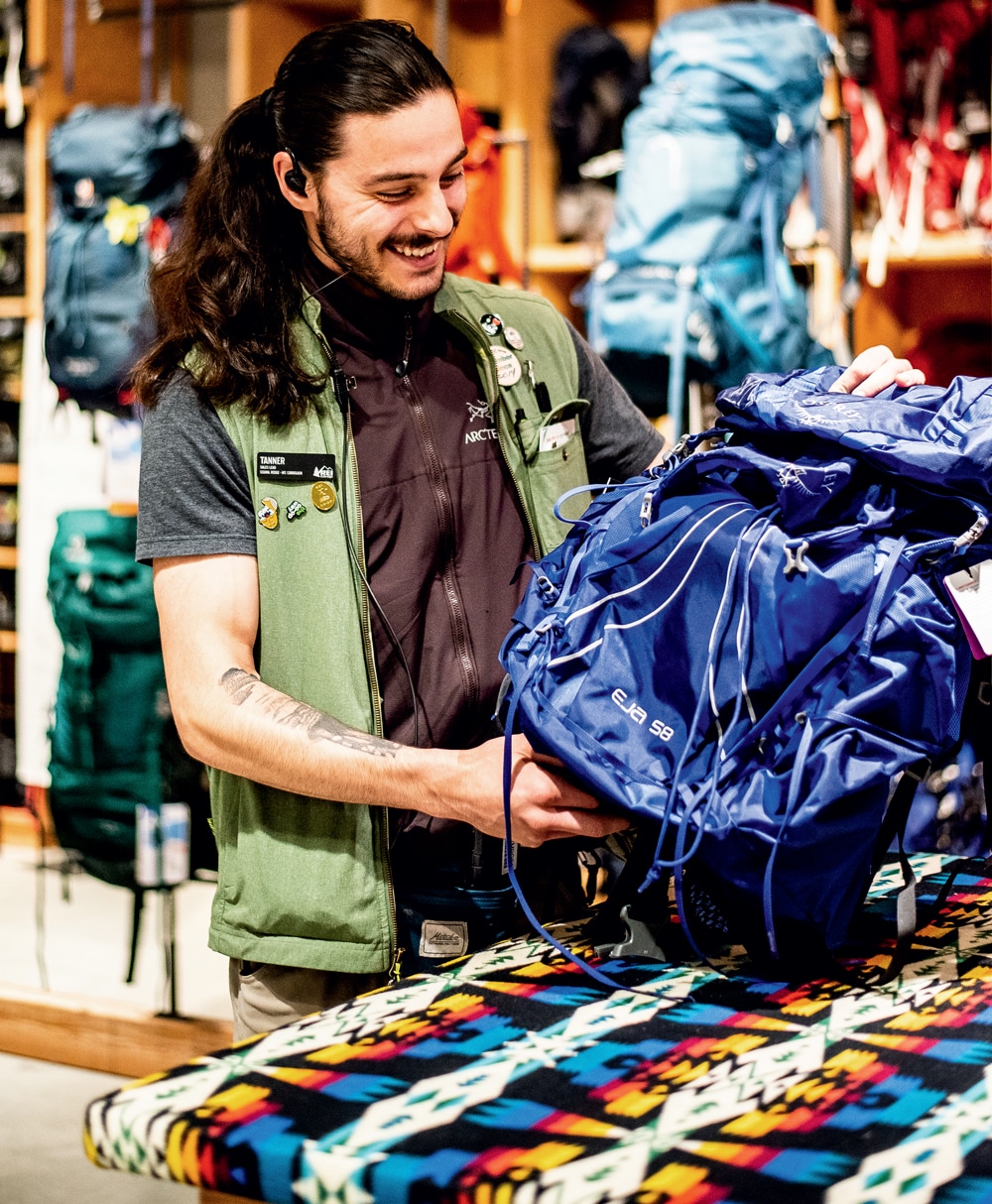
Photo Credit : Cait Bourgault
And oh, what a place to spend money. Behind a long wooden table, a bearded 20-something named Connor was handling the equipment rentals. His eyes grew large when I asked him about renting or maybe even buying some climbing skins for backcountry skiing.
“Dude!” he exclaimed. “I was just out this morning. Took a pair of Black Crows out that we rent. These things—you can practically dance in them.” He did a quick spin to emphasize his point.
Connor, who grew up in the area, pulled out the skis and boots, then walked me through the bindings with such obsessive detail it was almost as if he had invented them. “We’re all outdoor geeks, and every one of us had someone in our life who showed us how to do something that we’d never tried before,” he said.
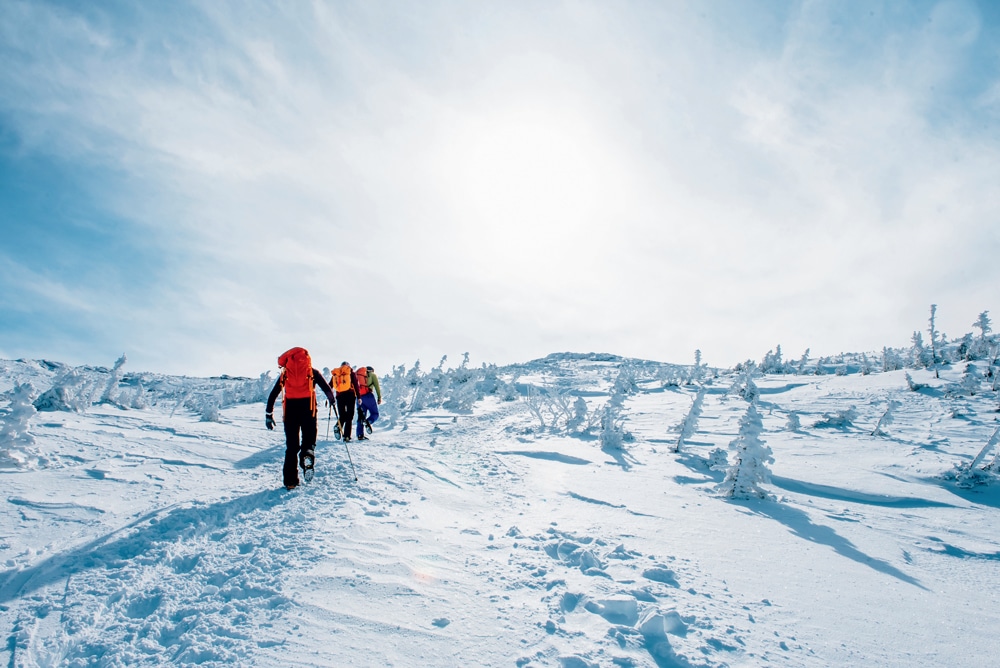
Photo Credit : Cait Bourgault
This kind of pay-it-forward attitude is a part of the Valley’s ethos. In the 1930s, after America’s earliest skiers tired of the farm hills and backyard runs that coursed through snow country, they cut trails in the mountains for bigger thrills, and northern New Hampshire became a major skiing destination. Cranmore emerged as one of the first ski resorts in the country. Black Mountain experimented with early ski-lift technology. Cannon opened the country’s first aerial passenger tramway in 1938, and in 1967 it hosted North America’s inaugural World Cup ski races.
Much of this history is colorfully told at the New England Ski Museum in downtown North Conway. A small museum shouldn’t be this good. Walking through it, you follow skiing’s wild evolution via a trove of early videos, posters, ski equipment, and clothing—but it also isn’t afraid to delve into the personal. America’s early skiing industry was built by men and women who brought a nothing-to-lose attitude to their endeavors. Here, you can find stories of the pioneers who carved out or rebooted their legacies in the Whites, including the so-called father of modern skiing, Austrian native Hannes Schneider, who landed in New Hampshire after imprisonment by the Nazis and who oversaw the development of Cranmore. You get a sense, for example, of what starting over for Schneider must have felt like when you see the weather-beaten suitcase and ski boots he brought with him to his new country.
—
Heather Chase’s journey to the Mount Washington Valley wasn’t nearly as grueling as Schneider’s, but like him, she found a home here. Chase grew up on an organic farm in Maine, arrived in the Whites via Dartmouth College in the early 1990s, and, like so many freshly minted grads, found the chance to “ski and play” too hard to resist.
Today, Chase is a clinical herbalist and holistic nutritional consultant who presides over her own mini wellness empire. In 2010 she took over a North Conway health food store and rechristened it the Local Grocer. She added a café (whose foods include many ingredients grown at the farm she and her partner, Russ Van Deursen, run in nearby Intervale) as well as studio space for yoga and reiki practitioners. And more recently, she reconfigured an adjacent building into Table + Tonic, a bistro that incorporates her own veggies, edible flowers, and herbs.
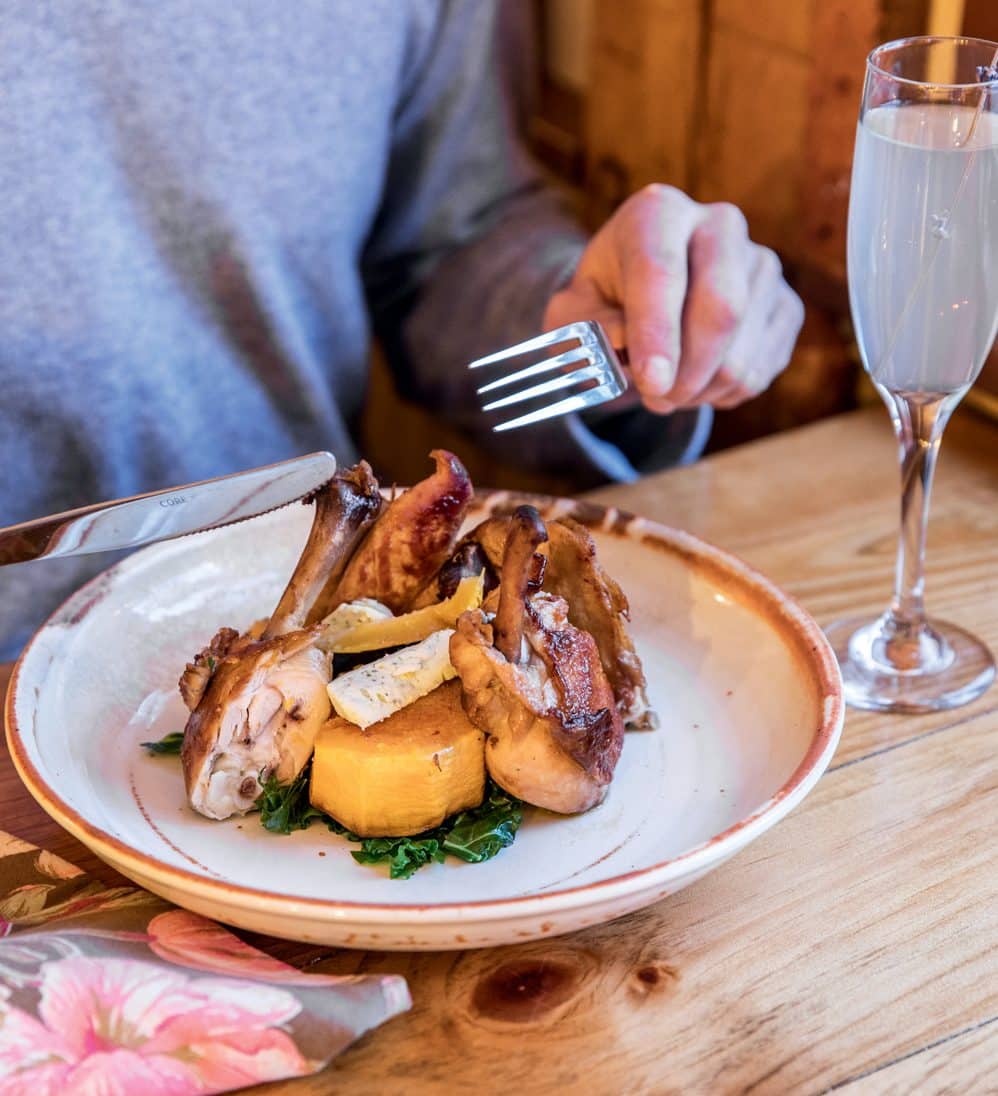
Photo Credit : Erin Little
I met Chase at Table + Tonic one weekday evening after a day of skiing. It was a quiet night, and as people filtered in, Chase circled the dining room, greeting them like family. In a region where pub restaurants almost outnumber the peaks, Chase’s eatery is a reminder that the Valley isn’t just about endorphins. A local spirit infuses everything about the place: The plates and mugs were made by an artist friend, the bar’s back wall is crafted from old barn boards, the tables were made from doors salvaged from the shuttered Balsams Hotel in Dixville Notch. It’s a space made for lingering on winter nights, even if the only thing you pluck from the menu is a cocktail enlivened with a house-made tonic.
“This is the kind of area that’s always offered something for everyone,” Chase told me. “It’s got the recreation, it’s got the shopping, and now we are starting to see a food scene.” She motioned toward a building site next door, where another business owner was constructing the state’s first organic distillery. “There’s a lot to be excited about.”
Reimagination and reinvention are hallmarks of the Valley. John and Mary Kendzierski know that as well as anyone. The couple own the Inn at Ellis River in Jackson, and my son and I met them one blustery afternoon after arriving at their doorstep looking and feeling haggard after a full day of skiing. Mary quickly dispatched our paperwork and got us to our room, where Calvin and I promptly collapsed on the bed to regain our legs for dinner.

Photo Credit : Cait Bourgault
The Kendzierskis’ path to the Mount Washington Valley followed the same course as many of their guests’. Drawn by its beauty and the ease with which two city folks could slide into outdoor culture, the Massachusetts couple began spending summer and fall vacations in the region in the late 1990s. They quickly homed in on Jackson, hopscotching around its various inns. In April 2014, the couple, who’d both spent years working in finance, learned that one of their favorite inns had hit the market. By fall, the two novice hospitality entrepreneurs owned the 22-room B&B.
“I remember we went out for a drink to celebrate, and just as we sat down we got a text message saying we needed to return to swap over the credit card processing system,” Mary said. “It was a sprint from there. It was foliage season, and I lost 15 pounds those first few weeks.”
Today, Mary runs the front of the house while John cooks up big breakfasts. There’s considerable online praise for the bacon, and my son stared in awe as a few giant strips arrived with his pancake plate. The inn’s spacious dining room allows for minimal morning chitchat if you are aiming to simply fuel up and hit the slopes. There’s a hot tub and a cozy bar where the ski muscles can relax a little further, something even the Kendzierskis have come to appreciate.
“We learned to ski last year,” said John, shaking his head seemingly in disbelief. “We might take time off during the day and zip over to Black Mountain to get in a few runs. Not that long ago, I was sitting with my daughter in the lodge. It was in the afternoon. We’d all been out together and I just kept thinking, I can’t believe this is my life.”

Photo Credit : Cait Bourgault
Not surprisingly, the Inn at Ellis River attracts a ski-obsessed crowd come winter. There’s a big downhill contingent, but many are here for the 450-plus kilometers of Nordic trails that slice through the Valley. More than a quarter of them crisscross Jackson, an 800-resident village that has become one of the cross-country power centers of the Northeast. The central hub is a short walk from the inn, and on a winter weekend as many as 1,200 skiers set off on trails that peel off from four main branch heads.
The hardest of the hard-core is a 17-kilometer descent off the back side of Wildcat Mountain, which you can reach by chairlift from the Alpine center. The trail features wooded glades and narrow, steep sections that cater to skiers I’m just going to defensively assume are aliens. On one visit, Calvin and I bypassed the gnarliest part of the route and took on one of the flatter legs of the Wildcat Trail, a wide and beautifully groomed section with straight, even stretches and soft turns. Along the way, we passed serenely slow skiers who were chatting with their partners, and we were passed by polite-but-on-a-mission skaters, who zipped up hills as though gravity were only a rumor. There wasn’t a bad mood among the bunch. When one of my bindings stuck, a stranger gave me a hand clipping in, then recommended a few trails to hit.
“You just gotta keep going,” she said. “Because the farther you go, the more beautiful it gets.”
Beyond just the surroundings, some of that chipperness is no doubt due to the work of the Jackson Ski Touring Foundation, the half-century-old nonprofit whose founders saw a chance to turn what was a struggling small town into a major sporting destination. Each winter it transforms the Wentworth Golf Club into its ski center, where it’s a no-fuss process to buy tickets or season passes, pick up rentals, and buy new equipment or other gear and clothing.

Photo Credit : Cait Bourgault
One morning I skied from the clubhouse, circling the course, then through a covered bridge (yes, really) before ducking into the woods to follow a path that largely tracked the Ellis River. Along the way was a scattering of the foundation’s touches, like the trail-side stands where the Jackson Public Library displays pages of a selected children’s book as a way to keep young skiers motivated. There was a warming hut about a mile and a half into the woods that sold hot chocolate. And just across the way, the playfully named “Jackson Hole” outhouse was available for public use.
There was also this: I was in the deep woods and I was not. That’s the thing about the White Mountains. If you come for that gnarly backcountry experience, it’s here. But really, you don’t have to venture too far to get a taste of the wilderness. You can get the rivers, the big snows, the big trees, and still just be a few miles from one of the best post-ski dinners you’ll ever have.
—
Of course, it’s impossible to tell the story of the Mount Washington Valley without a mention of its namesake, the imposing peak that hovers over the region like a god. Everything about the area is defined by the existence of Mount Washington—none more so than the grand hotel that bears its name.
When it was built in 1902, what is now the Omni Mount Washington Resort catered to trainloads of monied Bostonians and New Yorkers who were keen on northern pampering. Through boom years and leaner stretches, the hotel remained a seasonal destination. But then, two decades ago, it opened for winter guests and subsequently embarked on an ambitious run of expansions. It added a wellness center and spa and new luxury suites, and just this past year it built a new mountaintop lodge at Bretton Woods, the resort’s neighboring ski mountain.

Photo Credit : Cait Bourgault
Today it seems unfathomable that this hotel once shuttered when the snow hit. The truth is, you could build an entire winter vacation solely around a stay here. On its staff are expert ice climbing and winter hiking guides. Snowshoe and Nordic trails venture around the property, while Bretton Woods offers scenic downhill trails to rival any in the Northeast. Those same views of the western Whites are also available via the resort’s Canopy Tour, a through-the-woods zipline experience that features nine different lines and descends more than 1,000 vertical feet.
If you want to get a sense of just how varied the Valley’s winter visitors are, put in a good end-of-the-day hour by the fire in the Omni Mount Washington’s grand room. That’s where I stationed myself after a frigid afternoon at Bretton Woods. Around me swirled a mix of go-getters: two old friends discussing their snowshoeing route for the next day, a crew of young couples resting after a full day on the slopes, a retired couple occasionally looking up from their phones to talk about hitting the North Conway outlets the next morning.
But I suspect a common thread tied them all together. A place like the Omni Mount Washington puts you in the middle of the action and the beauty. Winter’s allure can be found whether you’re up high, in the woods, or gazing through giant picture windows at a sun-splashed peak early in the morning. In an age when the ability to wow has been diluted, when we can swipe and tap our way to practically any part of the planet, a visit to the Mount Washington Valley is a reminder of just how refreshing it can be to gaze up and look around. To appreciate the season.
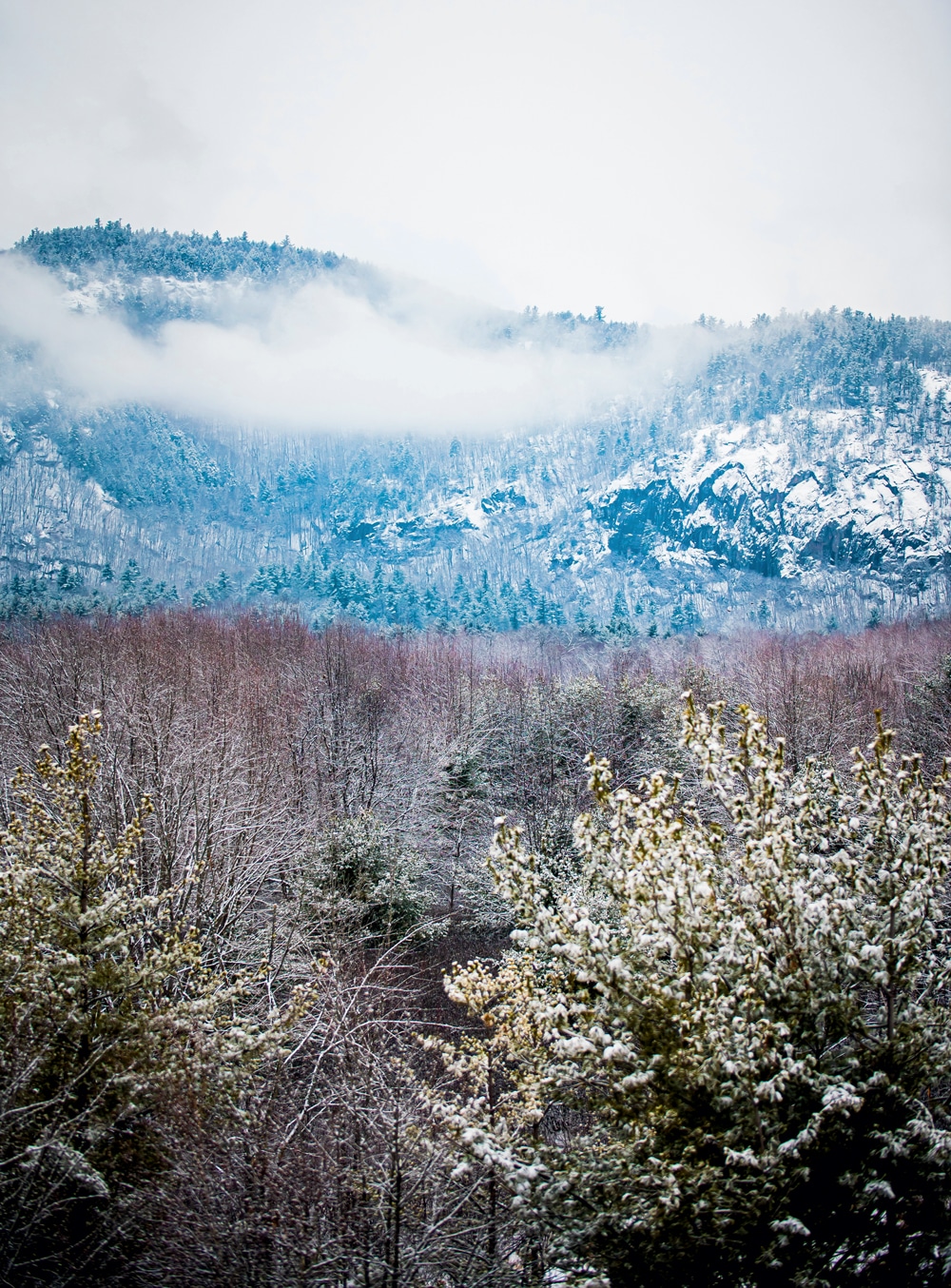
Photo Credit : Cait Bourgault
I was reminded of that on my final day in the Valley. I had returned to the region on my own, and steel-gray skies hung overhead. Powerful winds had forced a temporary closure of Wildcat; by midmorning, gusts had hit 127 mph atop Mount Washington and were swirling around half that at treeline. It seemed like a prime day, in other words, to see a little of the big mountain itself.
At the Great Glen Trails Outdoor Center I joined an older Massachusetts couple boarding a snowcoach for a partial ascent of the Mount Washington Auto Road. Built in 1861, the privately owned and operated road isn’t so much plowed in winter as it is flattened. The snowpack can build so high that it’s not uncommon for the road “surface” to be at treetop level in places.
Our driver, Mike Micucci, knew the route about as well as anyone. He’d led tours since he graduated from college some 40 years ago, and as we rumbled forward at a steady 15 mph, the landscape unspooled like a movie. The hardwood forest changed to softwood; we passed the spot where the Appalachian Trail crossed and peered out at the Great Gulf Wilderness and across the Presidential Range.
Micucci had driven the road in all seasons and in almost every kind of condition that could be thrown at him, and he didn’t hide his affinity for the passengers he enjoyed most. “Winter visitors are hardier,” he remarked as he pulled the snowcoach off at the four-mile marker. “It can be blowing 70 mph and there’s no visibility, and people will be like, ‘Bring it on.’ The summer crowds have higher expectations. We may have 100-mile visibility most of the trip, and then nothing for the last half mile and they’ll wonder if they should come back tomorrow. They want the conditions to be perfect.”
We hopped out of the vehicle and walked a short distance up the road. The wind howled, the air was freezing. We were all brimming with excitement. Micucci snapped a picture of me standing on the road, a colorless, unforgiving landscape at my back. In the months since, through the pandemic and stay-at-home orders, I’ve looked at that picture or thought about that moment. Invariably it leads to a conversation with my son about our time there. And often, he says the same thing.
“I can’t wait to go back.”
Neither can I.
More Photos from the Mount Washington Valley in Winter

Photo Credit : Cait Bourgault
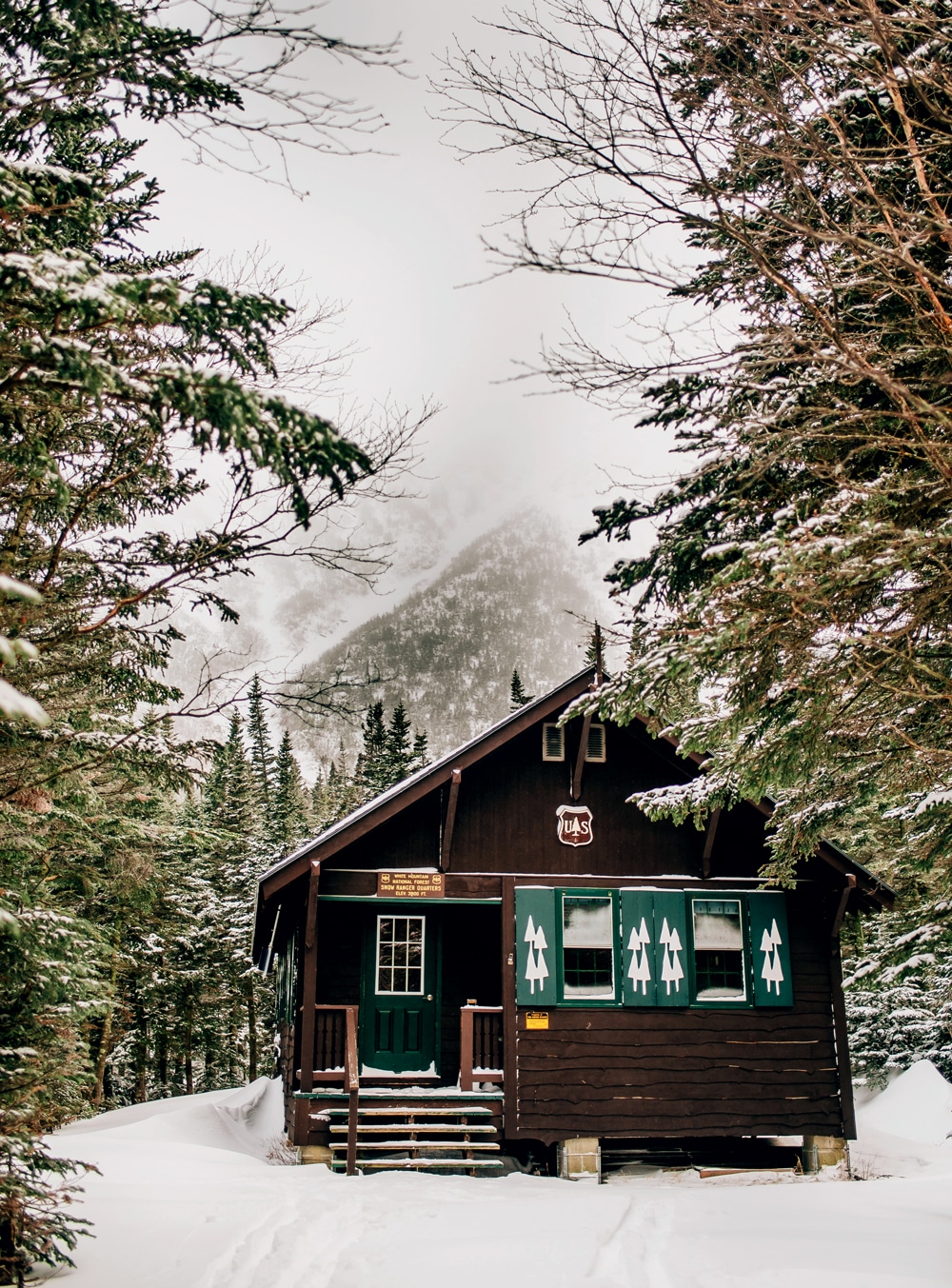
Photo Credit : Cait Bourgault
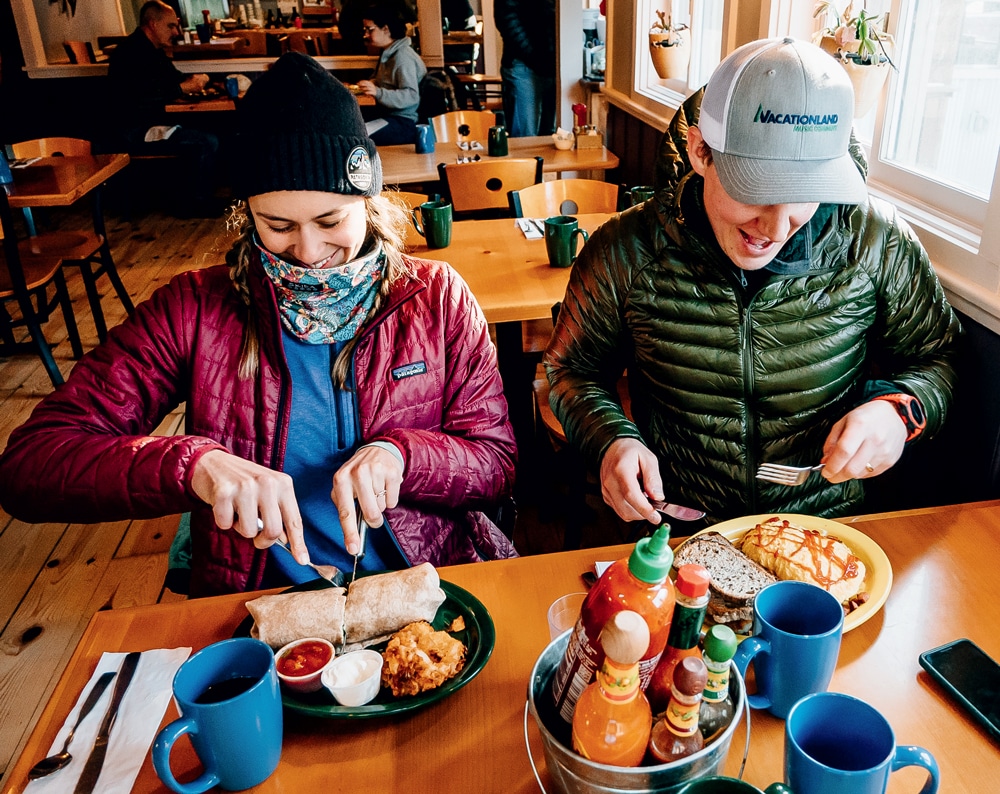
Photo Credit : Cait Bourgault
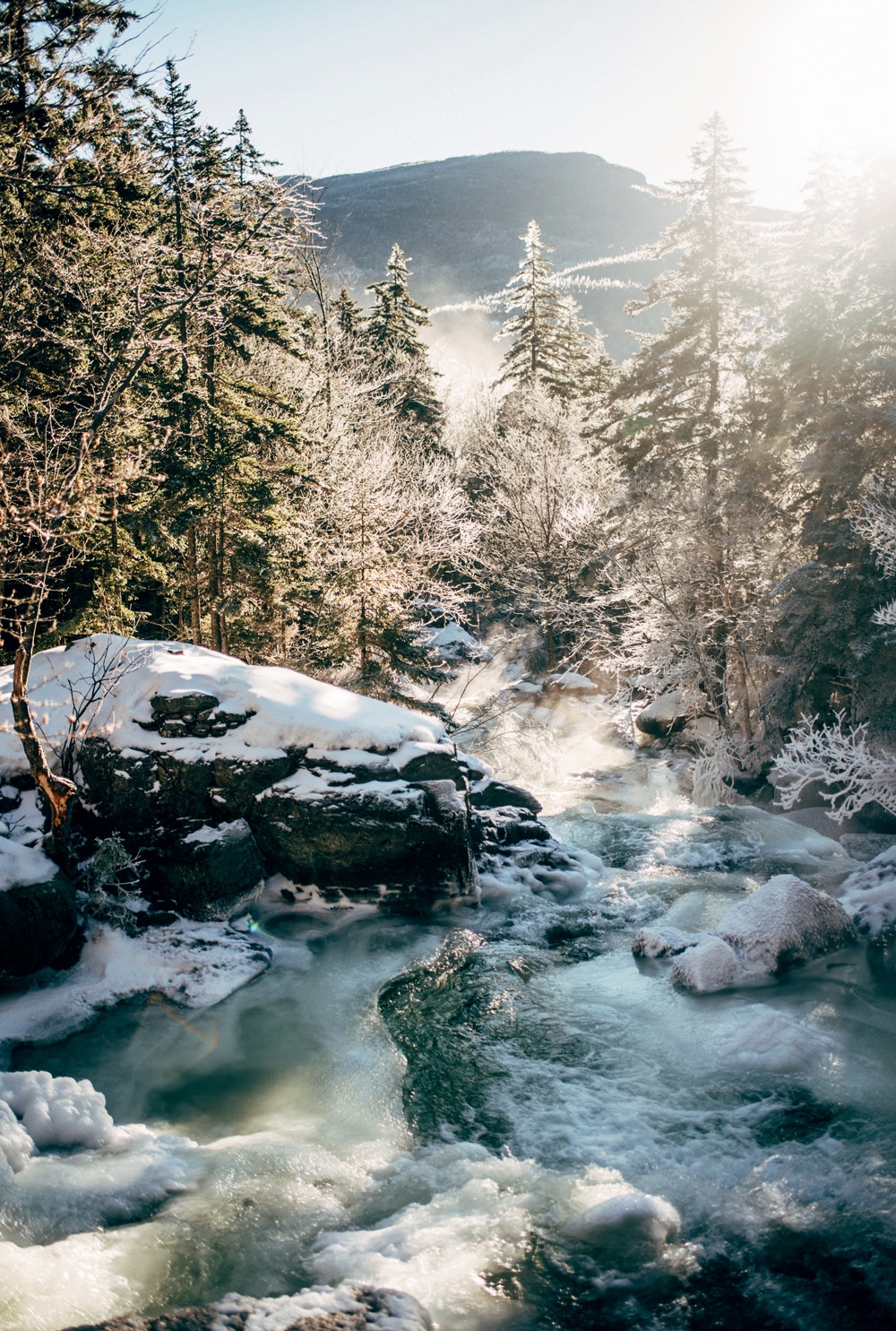
Photo Credit : Cait Bourgault

Photo Credit : Cait Bourgault

Photo Credit : Cait Bourgault
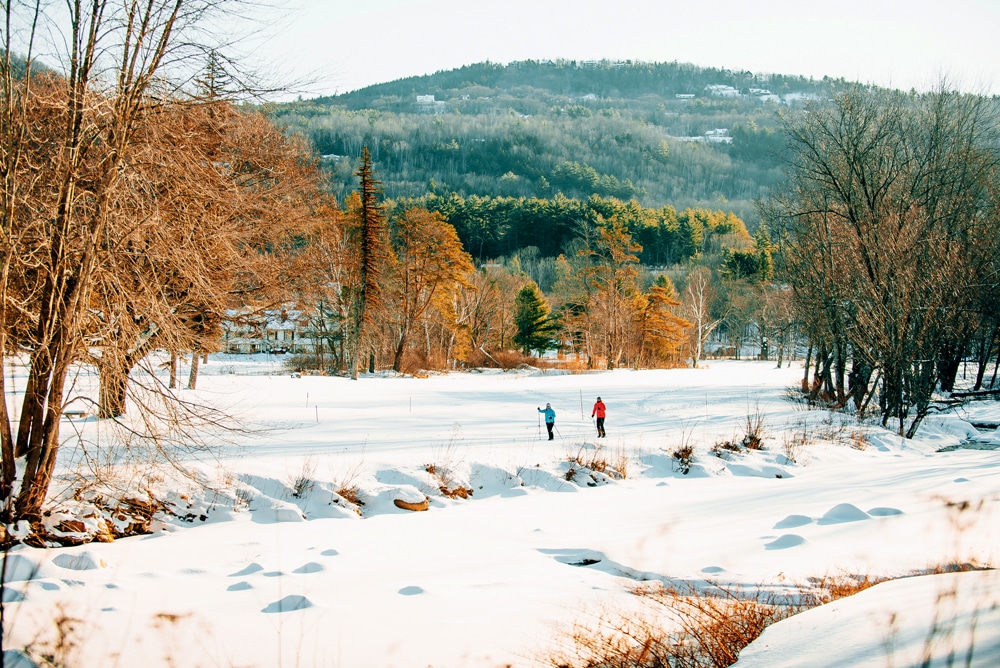
Photo Credit : Cait Bourgault
See More: Guide to New Hampshire’s Mount Washington Valley | Eat, Stay, Shop & Play
Ian Aldrich
Ian Aldrich is the Senior Features Editor at Yankee magazine, where he has worked for more for nearly two decades. As the magazine’s staff feature writer, he writes stories that delve deep into issues facing communities throughout New England. In 2019 he received gold in the reporting category at the annual City-Regional Magazine conference for his story on New England’s opioid crisis. Ian’s work has been recognized by both the Best American Sports and Best American Travel Writing anthologies. He lives with his family in Dublin, New Hampshire.
More by Ian Aldrich

